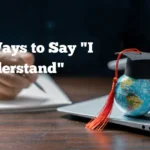Have you ever found yourself stuck using the word “means” again and again? I get it — it’s so easy to lean on simple words like that when we’re writing or speaking. But honestly, repeating the same word over and over can make your message feel dull or even unclear. Sometimes, you want your compliments, descriptions, or explanations to really shine with clarity and style. That’s where finding the other ways to say “means” can make a huge difference.
Imagine sounding more confident and creative in your writing or everyday conversations by swapping out “means” for some fresh, precise alternatives. It’s not just about sounding fancy — it’s about making your communication clearer and more engaging. When you use the right word, your ideas come alive and your listeners or readers pay attention.
In this post, I’m excited to share 25 powerful synonyms for “means” that will boost your vocabulary and give your language more color and personality. I promise you’ll find options that fit different tones and situations, whether you’re writing an essay, explaining something to a friend, or giving a compliment. Let’s dive in and discover these gems together — your words will thank you!
Alternatives to “Means”
1. Signifies
Signifies means to be a sign of something or to show its meaning clearly. It’s a strong word used when something clearly stands for or points to an idea or fact.
Usage Examples:
- A red light signifies that you must stop.
- Her smile signifies happiness.
- This symbol signifies danger ahead.
- The raised flag signifies the start of the race.
- His words signify his commitment to the cause.
Why it Works:
“Signifies” works well because it clearly points to a meaning or message, helping the reader or listener understand exactly what something stands for without confusion.
2. Indicates
Indicates means to point out or show something directly or indirectly.
Usage Examples:
- The results indicate a positive trend.
- His tone indicates frustration.
- The arrow indicates the direction to the exit.
- This mark indicates where to sign.
- Her hesitation indicates uncertainty.
Why it Works:
It’s great for showing evidence or giving clues about something, making your statement more precise and fact-based.
3. Represents
Represents means to stand in place of or symbolize something else.
Usage Examples:
- The dove represents peace.
- This chart represents sales data.
- She represents her country in the competition.
- The logo represents the brand identity.
- His actions represent his values.
Why it Works:
“Represents” is perfect when something or someone stands for or acts as a symbol of a bigger idea or group.
4. Implies
Implies suggests something without stating it directly.
Usage Examples:
- His silence implies disagreement.
- The tone of the email implies urgency.
- The dark clouds imply that it might rain.
- Her comment implies criticism.
- The contract implies certain responsibilities.
Why it Works:
Use “implies” when the meaning is hinted at, giving subtlety and depth to your expression.
5. Denotes
Denotes means to be a sign of something or to explicitly mean.
Usage Examples:
- A heart symbol denotes love.
- This word denotes a medical condition.
- The color green denotes safety.
- The label denotes the product’s origin.
- The number 7 denotes luck in many cultures.
Why it Works:
“Denotes” is clear and formal, perfect for precise definitions or descriptions.
6. Expresses
Expresses means to show or communicate feelings, ideas, or thoughts clearly.
Usage Examples:
- Her poem expresses deep emotions.
- The painting expresses joy and freedom.
- His tone expresses frustration.
- The letter expresses gratitude.
- The song expresses the struggles of youth.
Why it Works:
“Expresses” is perfect when you want to highlight how something communicates an idea or feeling directly and clearly.
7. Conveys
Conveys means to carry or communicate a message, feeling, or idea to someone.
Usage Examples:
- The film conveys a message of hope.
- His smile conveys friendliness.
- The design conveys simplicity and elegance.
- The speech conveys urgency about the issue.
- The gesture conveys respect.
Why it Works:
“Conveys” emphasizes the act of transferring meaning or emotion, making your language more vivid and descriptive.
Other Ways to Say “I Understand”
8. Symbolizes
Symbolizes means to stand for or represent something else, often an abstract idea.
Usage Examples:
- The eagle symbolizes freedom.
- White flowers symbolize purity.
- The broken chain symbolizes liberation.
- The dove symbolizes peace.
- The statue symbolizes courage.
Why it Works:
“Symbolizes” is great for when you want to connect something physical or visual to a bigger, often deeper meaning.
9. Suggests
Suggests means to put forward an idea or hint at something without stating it outright.
Usage Examples:
- The report suggests a possible solution.
- His expression suggests he knows the truth.
- The pattern suggests a trend.
- The data suggests a change in behavior.
- The story suggests a moral lesson.
Why it Works:
“Suggests” is useful when you want to express a hint or possibility, making your communication less direct but still clear.
10. Stands for
Stands for means to represent or symbolize something.
Usage Examples:
- The letters “CEO” stand for Chief Executive Officer.
- The red cross stands for medical aid.
- The flag stands for national pride.
- This emblem stands for the team’s spirit.
- Her actions stand for honesty.
Why it Works:
It’s an easy-to-understand phrase that works well for representing abbreviations, symbols, or ideals in everyday language.
11. Equals
Equals means to be the same as or amount to something.
Usage Examples:
- Two plus two equals four.
- Hard work equals success.
- Her happiness equals peace of mind.
- This sum equals the total cost.
- Their cooperation equals great teamwork.
Why it Works:
“Equals” is perfect when you want to stress equivalence or balance between things.
12. Refers to
Refers to means to mention or relate to something.
Usage Examples:
- The term refers to a type of bird.
- This chapter refers to historical events.
- His comment refers to the last meeting.
- The sign refers to the parking rules.
- The book refers to several famous scientists.
Why it Works:
It’s useful when you want to explain what a word, phrase, or object is connected to or about.
13. Shows
Shows means to make something clear or visible.
Usage Examples:
- The graph shows the rising temperature.
- His smile shows happiness.
- The map shows the way to the park.
- The evidence shows his innocence.
- The report shows a decline in sales.
Why it Works:
Simple and direct, “shows” is easy to use and helps illustrate facts or feelings plainly.
14. Designates
Designates means to officially choose or name something for a particular purpose.
Usage Examples:
- This area is designated as a no-smoking zone.
- She was designated team captain.
- The color blue designates water on the map.
- The badge designates rank.
- The label designates the product’s origin.
Why it Works:
It’s perfect when talking about formal naming, titles, or assigned meanings.
15. Marks
Marks means to indicate or be a sign of something.
Usage Examples:
- The end of the road marks the city limits.
- The trophy marks the winner.
- This date marks an important anniversary.
- The signature marks the agreement.
- The scars mark a past injury.
Why it Works:
“Marks” conveys clear boundaries or signs, which can be physical or symbolic.
16. Embodies
Embodies means to give a tangible or visible form to an idea, quality, or feeling.
Usage Examples:
- She embodies kindness and generosity.
- The statue embodies freedom.
- This policy embodies fairness.
- His behavior embodies respect.
- The book embodies the spirit of adventure.
Why it Works:
“Embodies” is powerful for showing how abstract ideas are expressed in real, visible ways.
17. Alludes to
Alludes to means to hint at or indirectly mention something.
Usage Examples:
- The poem alludes to ancient myths.
- His story alludes to personal struggles.
- The painting alludes to famous historical events.
- The song alludes to love lost.
- The speech alludes to future plans.
Why it Works:
It’s perfect for subtle references that add layers of meaning.
Other Ways to Say “In Terms of”
18. Points to
Points to means to show or direct attention to something.
Usage Examples:
- The evidence points to a suspect.
- Her reaction points to surprise.
- The arrow on the sign points to the exit.
- His words point to a solution.
- The data points to a problem.
Why it Works:
It’s clear and visual, great for guiding the audience’s focus.
19. Means to Say
Means to say is a conversational way to explain or clarify what you mean.
Usage Examples:
- What I mean to say is that we need more time.
- She means to say that she agrees.
- He means to say the plan is risky.
- They mean to say the project is delayed.
- I mean to say that you’re doing great.
Why it Works:
It’s friendly and informal, perfect for everyday conversation.
20. Connotes
Connotes means to suggest or imply an additional meaning beyond the literal.
Usage Examples:
- The word “home” connotes warmth and safety.
- The color black often connotes elegance.
- His smile connotes friendliness.
- This gesture connotes respect.
- The phrase connotes urgency.
Why it Works:
It’s excellent for discussing implied or emotional meanings.
21. Amounts to
Amounts to means to add up to or result in something.
Usage Examples:
- His silence amounts to agreement.
- The total cost amounts to $100.
- Her actions amount to betrayal.
- The report amounts to proof of guilt.
- This mistake amounts to a big problem.
Why it Works:
Good for explaining the end result or total effect.
Other Ways to Say “To Whom It May Concern”
22. Infers
Infers means to conclude or deduce information based on evidence.
Usage Examples:
- From his tone, I infer he is upset.
- The data allows us to infer a pattern.
- The question infers doubt.
- We can infer that she disagrees.
- The clues infer a hidden message.
Why it Works:
It’s useful for showing logical conclusions based on hints or facts.
23. Tells
Tells means to give information or reveal something.
Usage Examples:
- The clock tells the time.
- Her smile tells a story.
- The results tell us what to do next.
- The letter tells about their journey.
- The data tells the truth.
Why it Works:
Simple and clear, it emphasizes the act of communicating information.
24. Explains
Explains means to make something clear or easy to understand.
Usage Examples:
- The teacher explains the lesson well.
- This diagram explains the process.
- His answer explains the problem.
- The book explains complex ideas simply.
- The guide explains the steps clearly.
Why it Works:
Great for clarifying or breaking down information for better understanding.
25. Reveals
Reveals means to show something that was hidden or unknown.
Usage Examples:
- The test results reveal the truth.
- Her smile reveals her happiness.
- The document reveals new information.
- The investigation reveals facts.
- The painting reveals the artist’s skill.
Why it Works:
It’s perfect when uncovering or exposing meaning or information.
Conclusion
Thank you for sticking with me through this journey of discovering 25 powerful alternatives to the word “means.” It’s amazing how a simple change in wording can transform your writing and speaking, making your messages clearer, more interesting, and full of personality. Instead of leaning on the same old phrase, you now have a toolbox filled with bold, precise, and creative options to choose from.
By using words like signifies, conveys, implies, and embodies, you can express your ideas with greater style and confidence — whether you’re explaining, describing, or persuading. This not only helps your audience understand you better but also keeps them engaged and impressed with your language skills.
Remember, great communication is all about variety and clarity. So go ahead, experiment with these synonyms and watch how your writing and conversations improve. Your words deserve to shine, and now they will!

I’m Leo Knox, the wordplay wizard behind WordsTwists.com where I turn everyday meanings into funny, clever, and creative twists. If you’re tired of saying things the boring way, I’ve got a better (and funnier) one for you!


